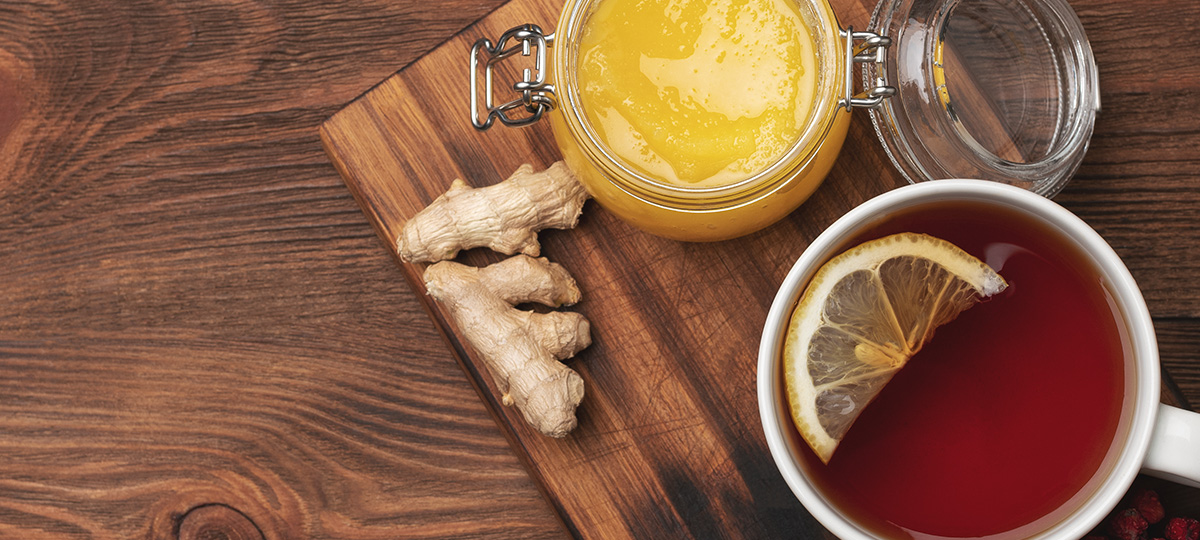5 Tips for Better Health During Winter
1. Boost your immune system. Winter is often associated with an increased risk of colds, flu and other illnesses. Prioritize your immune system by eating a balanced diet rich in fruits, vegetables and immune-boosting foods, such as citrus fruits, ginger, garlic and turmeric. Additionally, consider taking supplements like vitamin C or vitamin D, but be sure you consult with your physician before starting.
- Bonus Tip: Can honey help upper respiratory illness? The answer to that question appears to be yes. The Cleveland Clinic’s Dr. Elizabeth Rainbolt describes honey as having some anti-microbial and anti-inflammation properties, as well as potentially reducing mucus secretion. “So, you can use honey for cough symptoms as well, whether it’s a wet or dry cough,” she says in the hospital’s online newsletter Health Essentials. Take a spoonful (about a teaspoon worth) directly or dilute in hot water or tea. Dr. Rainbolt suggests limiting intake to four of five spoonfuls per day, and before giving to children, check with their pediatrician.
2. Practice good hygiene. During the winter, viruses and bacteria tend to be more prevalent. Follow good hygiene practices to reduce the spread of germs. Wash your hands frequently with soap and warm water for at least 20 seconds, especially before eating or touching your face. Use hand sanitizers when handwashing is not possible, and remember to cover your mouth and nose when coughing or sneezing.
- Bonus Tip: Did you know? According to the Centers for Disease Control and Prevention, hand sanitizers are an appropriate stand in for hand washing and work to quickly eliminate germs in many situations. But! Hand sanitizers do not get rid of every type of germ, and might not be able to remove harmful chemicals.
3. Take care of your skin. Cold weather, low humidity and indoor heating can lead to dry, itchy skin. Protect and moisturize your skin by using a rich, hydrating moisturizer regularly. Apply lip balm to prevent chapped lips and consider using a humidifier to add moisture to the air in your home or practice space.
4. Stay active. It can be tempting to hibernate indoors during the winter, but staying physically active is crucial for your overall well-being. Engage in regular exercise or find indoor activities that keep you moving, such as yoga, dancing or home workouts. Physical activity not only helps maintain your fitness but also supports your mood and energy levels.
5. Prioritize mental health. The winter season can sometimes be associated with mood changes or seasonal affective disorder (SAD) due to reduced sunlight and colder weather. Take steps to prioritize your mental health by getting exposure to natural light whenever possible, practicing self-care activities that bring you joy, and seeking support from loved ones or a mental health professional if needed.
- Bonus Tip: Light therapy can help. If you’re experiencing symptoms of SAD and live where natural sunlight isn’t always reliable, light therapy can help. Often called SAD lamps, these products are specially designed to mimic sunlight and can be effective when used for 20 to 30 minutes per day.
5 Easy Exercises to Enhance Your Self-Care
- Neck stretch. Gently tilt your head to one side, bringing your ear toward your shoulder. Hold the stretch for 15–30 seconds on each side. Repeat the stretch two to three times. You should feel a release of tension in the neck and upper shoulder area.
- Shoulder and chest stretch. Interlace your fingers behind your back and gently straighten your arms while squeezing your shoulder blades together. Hold the stretch for 15–30 seconds. This stretch helps counteract the forward hunching posture and relieves tension in the shoulders and chest.
- Wrist and forearm stretch. Extend one arm in front of you, palm facing up. With your other hand, gently pull your fingers down towards the floor until you feel a stretch in your forearm and wrist. Hold for 15-30 seconds and repeat on the other side. This stretch helps relieve tension and stiffness in the wrists and forearms.
- Standing forward bend. Stand with your feet hip-width apart. Slowly bend forward from your hips, letting your upper body hang down toward the floor. Allow your arms to dangle or reach for your shins or the floor. Hold the stretch for 15-30 seconds. This stretch helps release tension in the lower back, hamstrings and calves.
- Calf stretch. Stand facing a wall or sturdy object. Place your hands on the wall at shoulder height. Step one foot back, keeping it straight and pressing the heel down towards the floor. You should feel a stretch in the calf of the back leg. Hold for 15-30 seconds and repeat on the other side. This stretch helps relieve tightness in the calf muscles.
Remember to perform these stretches gently and within a comfortable range of motion. If you experience any pain or discomfort, please consult with a health care professional or a qualified physical therapist.
